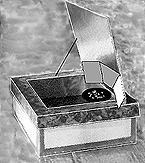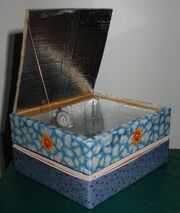(Added a long overdue section on panel cookers.) |
Tom Sponheim (talk | contribs) (Moved image) |
||
| Line 19: | Line 19: | ||
==Panel Cookers== |
==Panel Cookers== |
||
| ⚫ | |||
* Foods should be cooked in dark pans or canning jars that have been painted black (use masking tape to make a viewing strip). Pots that are otherwise suitable but too light in color can be painted on the '''outside''' with the non-toxic when dry spray paint. If you also want to use the pots on a conventional stove, use the black paint that is made for barbecue grills. |
* Foods should be cooked in dark pans or canning jars that have been painted black (use masking tape to make a viewing strip). Pots that are otherwise suitable but too light in color can be painted on the '''outside''' with the non-toxic when dry spray paint. If you also want to use the pots on a conventional stove, use the black paint that is made for barbecue grills. |
||
| Line 35: | Line 36: | ||
* If it seems as though your food is not heating evenly, give the pot a half-turn now and then. |
* If it seems as though your food is not heating evenly, give the pot a half-turn now and then. |
||
| ⚫ | |||
==Parabolic Cookers== |
==Parabolic Cookers== |
||
Revision as of 06:55, 1 February 2008
Box Cookers
- During optimal conditions, when cooking foods that take less than 3-4 hours, it is not necessary to turn the box to follow the sun. However, by turning the box more often you can increase the efficiency of your oven. For foods such as beans, it is essential to turn the box at least once.

Frying temperatures can be reached by using a shallow pan and an extra reflector.
- To achieve frying temperatures in a single reflector cooker elevate a shallow, dark pan (without a lid) so that it touches the glass inside. Then attach a small three-panel reflector that concentrates extra light onto this pan. Other food can be baked at the same time in the rest of the oven.
- If black pots or paint are not available, cook in clear jars. When using jars other than canning jars, the lids should be loosely closed to prevent explosions.
- If you are a single person cooking for yourself, or if you just want to experiment with solar energy, you can make your oven rather small. If you plan to cook for a family, then you will want to make yours close to the standard size (18" x 24" glazed opening) (45 cm x 60 cm), and you will want to make it more substantial to stand up to everyday use. One way to decide on the depth of your cooker is to measure the pans you will use. Make the cooker about 1" (2.5 cm) deeper than your pots are high (including lid).
- To allow easy removal of unwanted condensation between the double panes of glass in a wooden cooker, drill one or more holes into the airspace from the side. Stop these holes up with corks during normal cooking. To clear condensation between the panes, remove the corks and allow the cooker to heat.
- Build a cooker with the sides and glazing permanently attached. To open the cooker, lift this assembly off the base upon which the pots are resting.
- In areas where theft might be a problem, attach the lid with hinges and a padlock.
- In general, it's best to make your reflector as large as the entire lid -- not just the size of the glazed opening. This is true especially in areas far from the equator or when cooking during the winter.
Panel Cookers

Rocks are used to anchor this CooKit solar cooker so that it is not blown over by the wind at the Iridimi refugee camp in Chad.
- Foods should be cooked in dark pans or canning jars that have been painted black (use masking tape to make a viewing strip). Pots that are otherwise suitable but too light in color can be painted on the outside with the non-toxic when dry spray paint. If you also want to use the pots on a conventional stove, use the black paint that is made for barbecue grills.
- Pots or cooking jars need to be enclosed in an oven cooking bag or clear glass or plastic enclosure to help concentrate the heat. It is possible in some cases to just enclose the pot while leaving the lid exposed. Theoretically, the heat that is lost is made up for because you don't have to worry about condensation on the cooking cover blocking the sunlight.
- Whenever possible, work from behind the cooker, using the shadow to aim it. Wear sunglasses if possible, and try to avoid looking at the bright reflectors.
- If you are new to panel cookers, boiling water is a good way to get a feel for how they work.
- If you are making something like a soup or stew that mixes hard vegetable (carrots or potatoes, for example) with tender ones (spinach or baby peas, for example), add the hard vegetables first. Wait until your soup is boiling and the harder vegetables have begun to tenderize before you add the tender vegetables (but don't wait until the sun is too low to get it all hot again).
- Until you become confident with judging the sun and your cooker, vegetarian foods are safest.
- Panel cookers make wonderful soup stocks! Just stuff a cooking jar with vegetable scraps (tough asparagus stems and leek tops are especially good) and/or remnants of roast chicken or other meat scraps and bones, add some salt, a little wine or vinegar (this pulls calcium out of the bones and into your soup stock), some garlic and/or onion, and any herbs and spices you think would be good. Let it cook for a day, then strain, skim fat if needed, and use for the next day's soup.
- If it seems as though your food is not heating evenly, give the pot a half-turn now and then.
Parabolic Cookers
- Each time you finish cooking in an oven bag (with a panel cooker), turn the bag inside out to allow it to dry. Then use it inside-out the next time you cook.
General
- The single biggest reason for failure in solar cooking is not putting in the food early enough in the day. For this reason, it's best to follow the advice and "Get it on early, and don't worry about overcooking!"
- Foods take longer to cook when there is smog or haze. Since the clarity of the air can make as big a difference as the sun angle, learn to check out the color of the sky and adjust time accordingly. At times the sun may be shining, but the sky is white, indicating that smog or haze are present. A blue sky indicates clear air.
- While some cooking can be done in any non-reflective pot, ones made from thin, black metal work best. Cast iron works but its weight can delay cooking or inhibit it completely during marginal conditions. Shallow pans cook better than deep ones.
- If materials are scarce, build ovens made from papier maché held together with wheat paste. This can then be painted to make it waterproof. If sufficient paper is not available, try using corn husks or some other crop residue.

Easy Lid style box oven with fabric/glue/beeswax treatment.
- A cardboard cooker can be made water-proof using glue and wax (beeswax or candle wax):
- Cover the outside of the cooker with pieces of cloth that have been dipped in white glue or wheatpaste. Make sure the cloth adheres everywhere, applying extra glue to the loose spots. Allow to dry completely.
- For an alternative method that is much less messy and results in a smoother, better appearance, coat the relevant cooker surface with a thick but not dripping layer of white glue (a sponge brush works very well for this). Lay the fabric on the glue and smooth with a pad of paper towel. When fabric is lined up and smoothed out satisfactorily, use the sponge brush to completely cover the fabric with a generous amount of glue, making sure that the fabric is completely saturated with glue. Another layer of glue can be added once the first layer is dry, if it seems to need it.
- Rub a generous amount of wax over the entire cloth surface paying special attention to the seams.
- Heat the cooker near a fire or inside a larger solar cooker or other oven until the wax melts into the cloth. If the weather is warm and sunny, a parked car can also be used to melt the wax into the cloth.
- Repeat steps two and three until you are sure that beeswax has saturated the cloth completely. This process also strengthens a cardboard cooker to a significant degree. Testing is needed to see how these materials hold up over time.
- When arranging transport of solar ovens from a large city to rural users, Dick Wareham recommends finding free space on trucks heading back out into the rural areas after delivering their load of produce or other products in the city.
- Solar cookers as gardening equipment: 1) Gallon cans of dried manure or soil can be pasteurized to 150 degrees to kill wild seeds and insect eggs. 2) Plant material infected with insects, nematodes, or viruses can be cooked and dried in a solar oven and made safe to return to the garden or compost heap. This is particularly useful for greenhouses or urban gardeners. 3) Metal instruments can be sterilized as well as ceramic pots and wooden flats. 4) Water can be warmed in the field to soften plastic dripline fittings. 5) Pruning instruments can be sanitized either with dry heat or oiled and steamed.
- Some alternative cooking pots:
- Smoked-glass casserole dishes. Pyrex makes a low-cost model available for $5 - $10 in stores in the US.
- Rough up glass jars with sandpaper and paint these black. Use masking tape to leave one clear strip for viewing.
- Cook in gourds with a small sheet of glass for a lid.
- Put shiny pots in a brown paper sack.
- Paint a shallow cake pan black and fashion a lid from a sheet of black-painted aluminum flashing with its edges folded down.
- Buy dark baking pans in matched pairs and use one upside-down as a lid for the other. Metal binder clips of the right size—medium to large range, depending on the pan rims—work well for holding them securely together.
- Where large cardboard boxes are hard to find, you can glue together small boxes to form a larger cardboard sheet that can be folded into the shape of a larger box.
- When cooking uncovered cake or bread, sprinkle cinnamon on top to darken the surface and catch more sun. Doughs and batters containing eggs and milk will brown more readily.
- Heat dry grain in an SBC before storage to kill off any insect larva or eggs.
- We have learned with Rocket Stove experiments that floating a small amount of cooking oil on the surface of the food increases the efficiency of the stove significantly by preventing evaporation (which accounts for significant heat loss). In dishes such as rice or beans where some oil will be placed in the recipe anyway, try putting the oil on top and stirring it in later.
